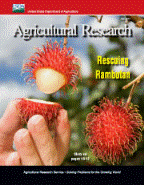United States Department of Agriculture: Agricultural Research Service, Lincoln, Nebraska

Agricultural Research Magazine
Date of this Version
1-2013
Document Type
Article
Citation
Agricultural Research January 2013.
Abstract
Biopesticides containing beneficial fungi are often grown on grains or other solids, but Agricultural Research Service scientists have found that a liquid diet might be cheaper and better. The approach, known as “liquid culture fermentation,” offers several advantages, including lower material costs and increased yields of certain forms of pestkilling fungi like Isaria or Metarhizium that can be sprayed directly onto crop plants or applied to soil as a biological alternative to using synthetic pesticides.
For decades, biopesticide makers have cultured fungi like these on moistened grains or other solid substrates to prompt them into churning out billions of specialized cells called “conidia,” or spores, which latch onto and then penetrate the cuticles of silverleaf whiteflies, aphids, and other soft-bodied insect pests, killing them within a few days.
Over the past several years, however, ARS microbiologist Mark Jackson and colleagues have sought to improve on the approach using liquid-culture fermentation methods in special tanks called “bioreactors.”
“We’ve made good strides,” reports Jackson, who is in ARS’s Crop Bioprotection Research Unit in Peoria, Illinois. “Optimizing fermentation conditions has increased the yield of spores, and we’ve identified low-cost nutrients that reduced production costs by 80-90 percent.”
One of the greatest reductions has been in costs associated with nitrogen as a primary fungal nutrient. One source, hydrolyzed forms of protein, is typically derived from agricultural commodities like milk casein, which can sell for more than $6 a pound. Jackson used less-expensive nitrogen sources, including soybean flour or cottonseed meal, which cost 30-50 cents a pound.
Conidia have long been the spores of choice for biopesticide uses, but other fungal cells can be just as effective, including yeastlike structures called “blastospores” and clumps of pigmented fibers known as “microsclerotia.” The latter can be easily and cheaply formulated as granules of almost any size for most application needs.
In the case of M. brunneum (formerly M. anisopliae), for example, Jackson, together with Stefan Jaronski, an entomologist in ARS’s Pest Management Research Unit in Sidney, Montana, demonstrated that the soil-dwelling fungus performed best when cultured and applied as microsclerotia. Fungi in this intermediate survival stage only produce conidia in soil when conditions are optimal. In laboratory tests, conidia resulting from microsclerotia treatments killed 100 percent of sugarbeet root maggots in 1 week versus 25 percent killed in 3 weeks using a conidia-only, corn-granule formulation. (See “Multiplying Metarhizium,” September 2008, pages 4-5.)
Included in
Agriculture Commons, Animal Sciences Commons, Food Science Commons, Plant Sciences Commons

